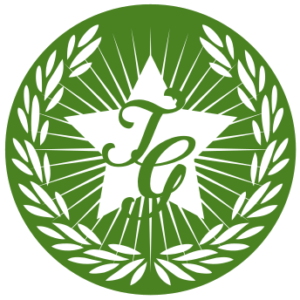The birth of agriculture in Britain
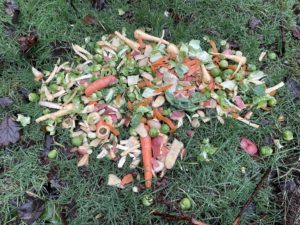
A pile of vegetables and peelings on some grass: carrots, potatoes, parsnips, and Brussel sprouts.
Colin was a JJytgHQp (pronounced Thrussup) and has been living in and around Leith Hill since Neolithic times. He and a band of 40 brothers and sisters arrived in Britain in 4036 BCE with not much more than the multicoloured shells on their backs. They were quite a sight to behold, or so I’ve been told, emerging from the sea at various points around the Welsh and Cornish coasts. Like merpeople, but with less cultural baggage.
At first, the inhabitants of Britain didn’t pay them no mind, as the island was sparsely populated and sharing was not a problem. There were a few ladies, of course, who wondered if the JJytgHQp’s shells could be repurposed into shelter, wind chimes, or clothing, but no one was rude enough to try to take the shells off the JJytgHQp’s back. Except, of course, Rapskalbana.
Rapskalbana was the most daring lady of Britain, although she didn’t actually know that. She was referred to locally as ‘the most irritating and likely to get into trouble albeit with generally favourable outcomes in the end’; trouble for short. Rapskalbana didn’t care too much about other people’s opinions, and was often away from her community trying out traditional carving techniques on non-traditional objects. It is to her we can thank the performative treasures of ceremonial axe-heads, for instance.
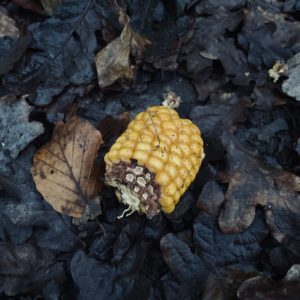
Photo of an end of a corn cob on some old, brown, wet leaves. Some corn kernels remain but some have been eaten.
One day when Rapskalbana was out looking for shells sturdy enough to build a display case for her collection of decorative spoons, she came across a broken section of the most spectacular multicoloured JJytgHQp shell. Until now, Rapskalbana had not encountered a JJytgHQp, as the two species had mostly kept a safe and respectful distance. In fact, the JJytgHQps had retreated into the centre of the island where the humans rarely ventured.
Rapskalbana’s eyes lit up when she found the fragment of JJytgHQp shell, and she knew instantly that it was just the material she had been looking for. So she scouted about for tracks to follow and eventually located Colin’s footprints entering the forest which was unusually close to this particular shore.
For three whole days Rapskalbana tracked Colin, going deeper and deeper into the interior of Britain and away from the places known to humans. Eventually, she came to a giant mound of multicoloured objects, and she knew that she had found some kind of ritual offering. She was wrong, of course, but her curiosity is what counts. She circumnavigated the perimeter of the mound three times, seeking, and failing, to find its celestial alignment; eventually she settled down into a contemplative, but exploratory, crouch.
Unbeknownst to Rapskalbana, Colin looked on from his hiding place deep in the moss-covered forest. He was nervously chewing his fingershells and wondering what would happen next. To his utter horror, Rapskalbana reached down and picked up one of the multicoloured objects. It was softer than she expected; after turning it over in her hands, she gave it a good sniff, and then stuck out her tongue to give it a taste when…
‘OH MY GOD STOP!’, shouted Colin.
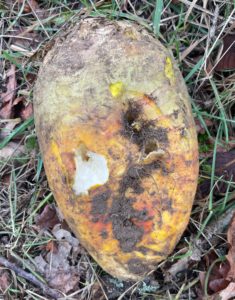
Photo of a turnip on some grass with a nibble taken from it. Only a small nibble, because, as we all know, turnips are disgusting.
Rapskalbana’s tongue retracted as she spun around to locate the source of the shout, and found Colin with his shimmering shell standing there with his hands pressed against his face in anguish. Fortunately, as Rapskalbana was the most daring lady in Britain, her courage didn’t falter, and as Colin was fourteen times taller than her, neither did his. So they were able to settle down to a nice bit of conversation.
It’s quite difficult for me to give an accurate account of what Rapskalbana and Colin spoke about, as Colin, like all JJytgHQps, is from Syria and I don’t speak Arabic. However, I have been reliably informed by Vernon that the two made an admirable attempt at communication through the use of pictograms, gesticulations, and grunts.
It turns out that those ‘multicoloured objects’ are what we modern folk refer to as vegetables, and that first meeting between Colin and Rapskalbana was actually the birth of modern agriculture. Colin explained that the multicoloured objects were spontaneously shed by JJytgHQps throughout the late spring and summer, and even, for one or two of the JJytgHQps, well into the winter. As such, the centre of Britain where the JJytgHQps dwelled was getting full of these objects. They had piled them into mounds and mountains, but they were running out of space.
Like you, no doubt, Rapskalbana wanted to know more about the process of shedding, and so Colin let her have a peak under his shell. It turns out that a great variety of plants were growing there and it was their fruiting and rooting bodies that the JJytgHQp shed. More precisely, every bead of JJytgHQp sweat turned into a seed which burrowed down under their shell into their soft and protected flesh, and then a plant, as unique to them as our pheromones are to us, would grow.
As we know, Rapskalbana had been tracking Colin for some time, and so was not a little bit hungry. She picked up another ‘vegetable’, took another sniff, and then asked Colin if he would be amenable to her having a taste. Colin was uncomfortable about this, as from his perspective it was cannibalism, but he was also a pragmatic sort: it wouldn’t technically be cannibalism for a non-JJytgHQ to eat it, and it could solve a problem…
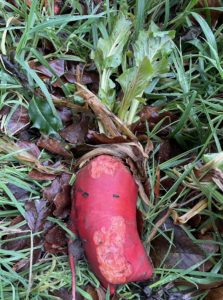
Photo of a red sugar beet dug up and laying on some grass. There are parts nibbled from it and it looks like it has a face screaming. Imo, it represents Colin’s sculptural style.
To cut a long story short, after a brief taste-testing, our audacious Rapskalbana saw an opportunity and offered to take the ‘vegetables’ back to her people. As time went on, a trade developed between the humans and the JJytgHQ. Well, I say trade, but really the humans just did the JJytgHQ a favour by eating their excrement, alongside the meat, fat, and organs from the animals they hunted. Then one day, as a JJytgHQ called Safina was delivering a load of ‘vegetables’ to a human encampment, she wiped her most delicate of brows and a bead of her rose scented sweat fell onto the ground. By summer, it was a giant vine of tomatoes.
Those plucky humans spied an opportunity and the next time a JJytgHQp came to their encampment, they ensured a fire or four was raging. Again, a bead of sweat fell to the floor, and this time it grew into carrots. On and on this went until the humans didn’t need the JJytgHQ any more, so they ate them.
Colin is the last of his type. He wanders Leith Hill lonely and afraid, shedding his matter in discrete piles and even artfully sculpting them sometimes to try to prove his worth. I personally found some in Abinger Common, Abinger Bottom, and Holmwood. I did call out to him, but he did not come forth, alas, so I could not interview him for this story. Dear Colin, if you are reading this, I’m a carnivore, so you and your sheddings are safe from me, I promise.
